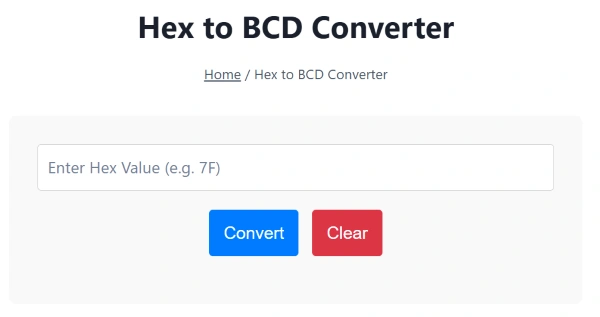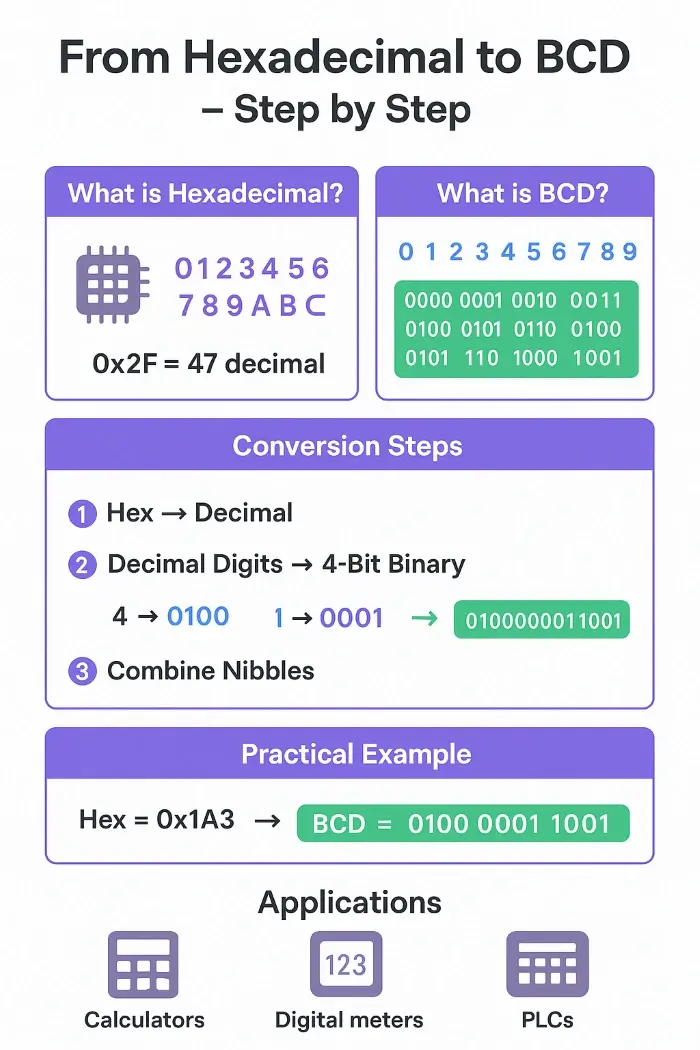Hex to BCD Converter
Reverse Conversion Tool: BCD to Hex Converter
Convert hexadecimal numbers to Binary Coded Decimal (BCD) format instantly with our free online hex to BCD converter. This essential tool bridges the gap between hexadecimal representation and BCD encoding, making it invaluable for digital electronics, embedded systems programming, and microcontroller applications.
The hex to BCD converter image is shown below:

Understanding Hexadecimal and BCD Systems
Hexadecimal is a base-16 number system using digits 0-9 and letters A-F, where each digit represents values from 0 to 15. This compact representation makes hexadecimal ideal for programming and digital systems. For complex hexadecimal calculations before conversion, our hex calculator provides comprehensive arithmetic operations including addition, subtraction, multiplication, and division.
Binary Coded Decimal (BCD) represents each decimal digit using a 4-bit binary sequence called a nibble. Unlike standard binary representation, BCD maintains the decimal digit structure, making it perfect for applications requiring decimal precision, such as digital clocks, calculators, and display systems.
How Hex to BCD Conversion Works?
The hex to BCD conversion process involves three straightforward steps that ensure accurate transformation from base-16 to decimal-preserving binary format:
Step 1: Convert Hexadecimal to Decimal First, convert your hexadecimal number to its decimal equivalent. For example, hex value 0x2F equals 47 in decimal. You can verify this conversion using our hex to decimal converter for accuracy.
Step 2: Convert Each Decimal Digit to 4-Bit Binary Take each decimal digit and convert it to its 4-bit binary representation:
- 4 becomes 0100
- 7 becomes 0111
Step 3: Combine the Nibbles Concatenate the binary nibbles to form the final BCD representation: 01000111.
Practical Conversion Example
Let’s convert hexadecimal 0x1A3 to BCD format:
- Hex to Decimal: 0x1A3 = 419 decimal
- Digit Conversion:
- 4 → 0100
- 1 → 0001
- 9 → 1001
- Final BCD: 010000011001
This systematic approach ensures accurate conversion while maintaining the decimal digit structure that makes BCD valuable in digital applications.

Applications and Use Cases
Hex to BCD conversion serves crucial roles in various technical domains:
Digital Display Systems: BCD format directly drives seven-segment displays and LCD panels, eliminating the need for decimal-to-binary conversion in display controllers.
Embedded Programming: Microcontrollers often use BCD for time-keeping functions, calculator implementations, and user interface displays where decimal accuracy is paramount.
Legacy System Integration: Older computer systems and industrial equipment frequently employ BCD encoding, requiring conversion from modern hexadecimal data formats.
Data Processing: When working with ASCII-encoded hexadecimal data, you might first need our ASCII to hex converter before performing BCD conversion.
BCD vs. Standard Binary Conversion
Understanding the difference between BCD and standard binary conversion is crucial for proper implementation. While our hex to binary converter transforms the entire hexadecimal value into one continuous binary string, BCD maintains decimal digit boundaries.
For instance, hex 0x25:
- Standard Binary: 100101 (37 in binary)
- BCD: 00100101 (2 and 5 as separate decimal digits)
This distinction makes BCD ideal for applications requiring decimal digit manipulation and display formatting.
Advanced Conversion Scenarios
Multi-byte Hexadecimal Values: Large hex numbers require careful digit separation. Convert 0xABC (2748 decimal) by processing each decimal digit: 2→0010, 7→0111, 4→0100, 8→1000, resulting in BCD 0010011101001000.
Fractional Considerations: While BCD typically handles integer values, some applications extend BCD to represent decimal fractions using additional nibbles for fractional digits.
Validation and Error Handling: Always validate input hex values and ensure BCD output doesn’t exceed system constraints. Invalid hex characters or overflow conditions require proper error handling in implementation.
Programming Implementation Tips
When implementing hex to BCD conversion in code, consider these optimization strategies:
- Use bit shifting operations for efficient nibble extraction
- Implement input validation to handle invalid hexadecimal characters
- Consider memory constraints when processing large hex values
- Test edge cases including zero values and maximum system limits
For verification of your hexadecimal arithmetic during development, utilize our online hex calculator to ensure accuracy in complex calculations.
Related Number System Conversions
Hex to BCD conversion often works alongside other number system transformations. Our conversion toolkit includes decimal to hex for reverse operations, hex to octal for alternative base conversions, and binary to hex for working with raw binary data.
Understanding these interconnected conversions enhances your ability to work across different number systems efficiently, whether you’re developing embedded applications, debugging system code, or interfacing with legacy hardware.
FAQs About BCD to Hex Converter
Q1: What is a common programming approach to convert hex to BCD?
A1: A typical method iterates through each hexadecimal digit, converts it into its 4-bit binary equivalent, then concatenates each binary nibble to form the full BCD output. This nibble-wise processing ensures digit-by-digit accuracy.
Q2: How can bit-shifting optimize hex to BCD conversion in code?
A2: Bit-shifting operations allow isolated processing of each hex digit by extracting nibbles directly from the hex number without string manipulation, enhancing both speed and memory efficiency in embedded or performance-critical environments.
Q3: Are there hardware-level implementations for hex to BCD conversion?
A3: Yes, microprocessors and embedded systems often implement hex to BCD conversion routines in assembly language using iterative subtraction and addition to handle digits, allowing BCD output suited for direct hardware display interfaces.
Q4: What techniques handle large or multi-byte hex values converting to BCD?
A4: Large hex numbers can be converted by chunking into smaller segments, converting each segment to decimal or binary-coded decimal separately, and then combining results carefully to maintain digit boundaries and avoid overflow.
Q5: How is error handling typically performed during conversion?
A5: Effective input validation includes checking for valid hex characters before conversion, bounding the size of input data to prevent overflow in BCD buffers, and handling edge cases such as zero or maximal hex values gracefully.
Q6: Can fractional hex values be converted to BCD?
A6: While standard BCD focuses on integers, some implementations extend to fractional values by encoding digits after the decimal point as additional 4-bit groups, although this requires clear specification of the decimal point position and handling.
